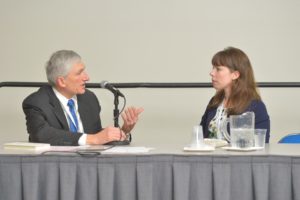
About three years ago, my 72-year-old mother experienced a traumatic accident – she fell down a flight of stairs in her home and lay at the bottom until she was discovered nearly five hours later. The inventory of injuries included a fractured clavicle, eight broken ribs, two possible pelvic fractures, kidney damage, and pleural effusion. The experiences of her nearly month-long hospital stay convinced me that nothing could prepare the health professionals treating her better than either being patients themselves or being educated by patients. Some of these experiences included:
- An ER doctor mumbling to a colleague within earshot of me, my sister, and mother upon arrival, “I hope I don’t kill anyone today.”
- ER staff members, who perceivably had not seen each other in a long time, hugging and greeting each other heartily next to my mother’s bed in the trauma bay, while my sister and I waited behind a thin curtain to learn of her fate.
- Limited communication or coordination between the many professionals treating her, including orthopedic surgeons, cardiologists, internal medicine specialists, and critical care physicians.
- Being told by a charge nurse, after my mother was transferred to another hospital at 2:00 a.m., that I had to wait in the waiting room until visiting hours the next morning at 8:00 a.m. Otherwise, I could pay a $750 fee to have her moved to a private room (she was in a double room with no roommates).
As I reflected on these events, I wondered if things would have been different if some of the professionals involved in my mother’s care had been educated by patients. If they had heard some of the same things my mother and her family had heard in the hospital and knew how they impacted us, would they have thought twice about saying them? I wondered if there was an educational opportunity for health professionals to hear the patient’s and family’s perspective and integrate it into how they provide care. The answer, I think, is a resounding yes!
Partnering with Patients in Health Professional Education
I’m fortunate to work for an organization, the American College of Physicians, which has embraced the concept of patient- and family-centered care. ACP has developed four principles of patient partnership, including one about partnering with patients in health professional education.
For the past four years, ACP has held an educational session at its annual meeting entitled, “In the Patient’s Voice.” For the first three years, this session featured patient speaker, Vance Taylor. He was diagnosed with muscular dystrophy at the age of seven and has had to cope with the unique challenges of living life with a neuromuscular disease. At the time of his diagnosis, Mr. Taylor was told by his doctors that he would never graduate high school, attend college, or live independently. However, Mr. Taylor and his family dismissed this pessimistic prognosis and partnered with physicians who shared the family’s goals. The session appeals to the imagination of the internal medicine physician attendees, who are led by Vance’s words to the doctor’s appointment when he and his family were essentially told that his life was worthless.

Steven Weinberger, MD, former EVP and CEO of the American College of Physicians, talks with Lucy Kalanithi, MD, at the “In the Patient’s Voice” session at the ACP 2017 annual meeting.
During ACP’s 2017 annual meeting, Lucy Kalanithi, MD, was invited to give the “In the Patient’s Voice” session. Lucy’s husband, Paul Kalanithi, MD, died from lung cancer at the young age of 37 in March 2015, and she wrote the epilogue to his book, When Breath Comes Air. The “In the Patient’s Voice” sessions are always highly rated and there are typically tears and inspirational discoveries in every question-and-answer period at the close of the session. The sessions offer lessons in compassion, humanism and empathy. However, as heart wrenching, rousing and motivating as these sessions are, are they enough to make a true impact on the way health care is provided? My hypothesis is probably not, but they are a step in the right direction.
As ACP has evolved its commitment to partnering with patients in health professions education, we have explored a variety of engagement strategies. Many sessions at our annual meeting and other educational events are co-designed and presented by patients and families. For example, patients and physicians presented last year about how having open electronic health records facilitated more effective communication around the care plan. Patients and physicians, along with other interprofessional team members, also partner on developing educational resources for ACP’s physician members. A patient/physician team developed an educational module about supporting patients in managing their medications. It was the patients’ contribution to title the module, “collaborative medication management” as opposed to the better known, but somewhat punitive concept, “medication compliance” or “adherence.” In other instances, patients have provided perspectives on shared decision-making tools for cancer screenings, reminding physicians that financial issues often need to be considered when making decisions. It is now standard practice for patients to partner on development of educational resources for ACP.
Additionally, ACP invited nine patient and family advisors to last year’s annual meeting (typically attended by only physicians) to provide observations and recommendations for how to further engage patients and families in future educational opportunities. The group recommended:
- Inviting patients to serve on the curriculum planning committee for educational events
- Having patients review proposals submitted for educational sessions
- Developing specific educational tracks related to patient- and family-centered care
- Partnering with more patients as faculty for sessions
As a result of this group’s work, a new high-profile Grand Rounds educational event, featuring both a physician and patient, will be held at future annual meetings.
While these initiatives are just a start, it is my assertion that partnering with patients in health professional education will result in more compassionate and considerate care. Providing clinical information interwoven with patient experience should truly be the gold standard. With the expansion of these efforts—not only by ACP, but many other organizations—hopefully no other patient or family will be subjected to hearing a trusted health professional say, “I hope I don’t kill anyone today.”




